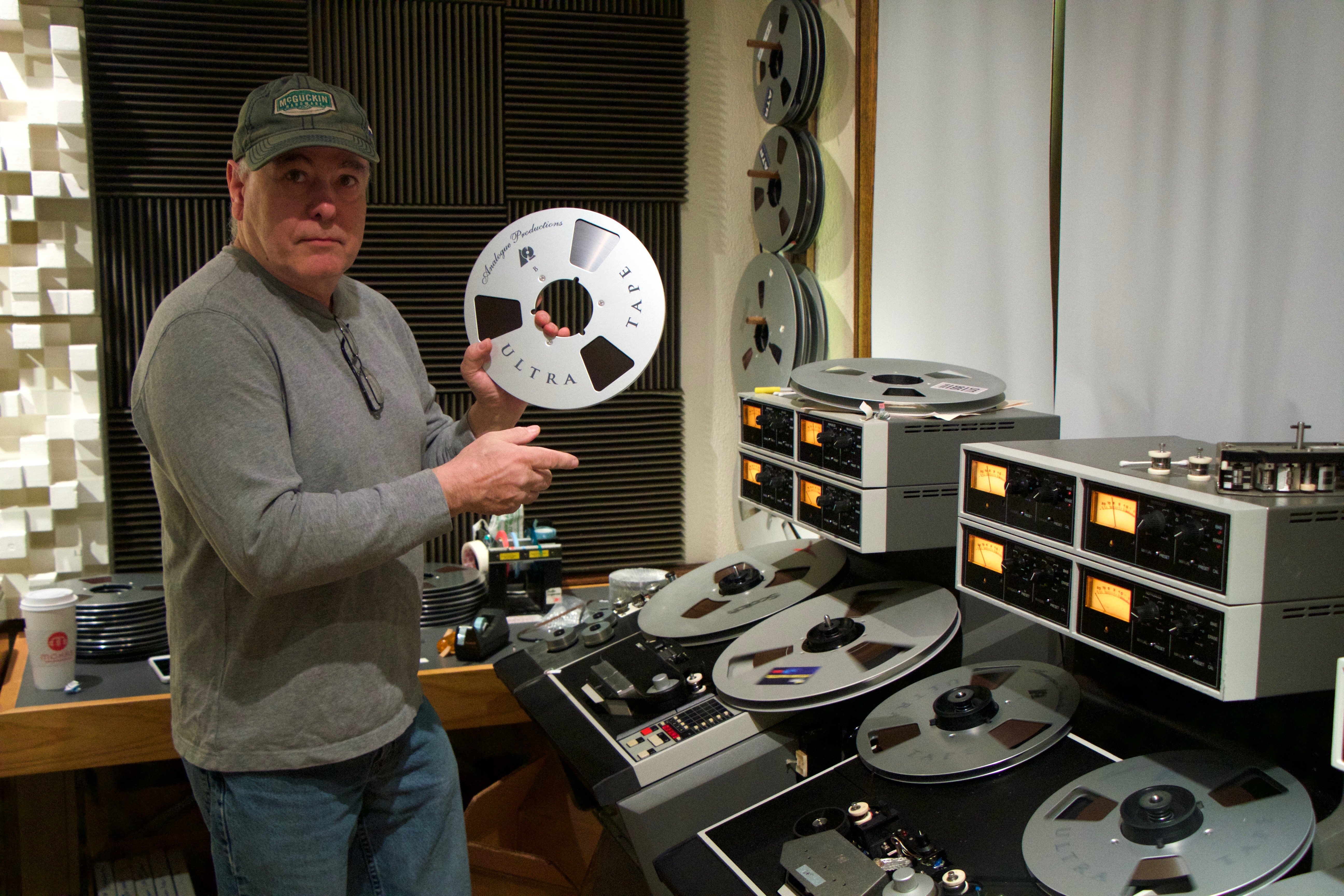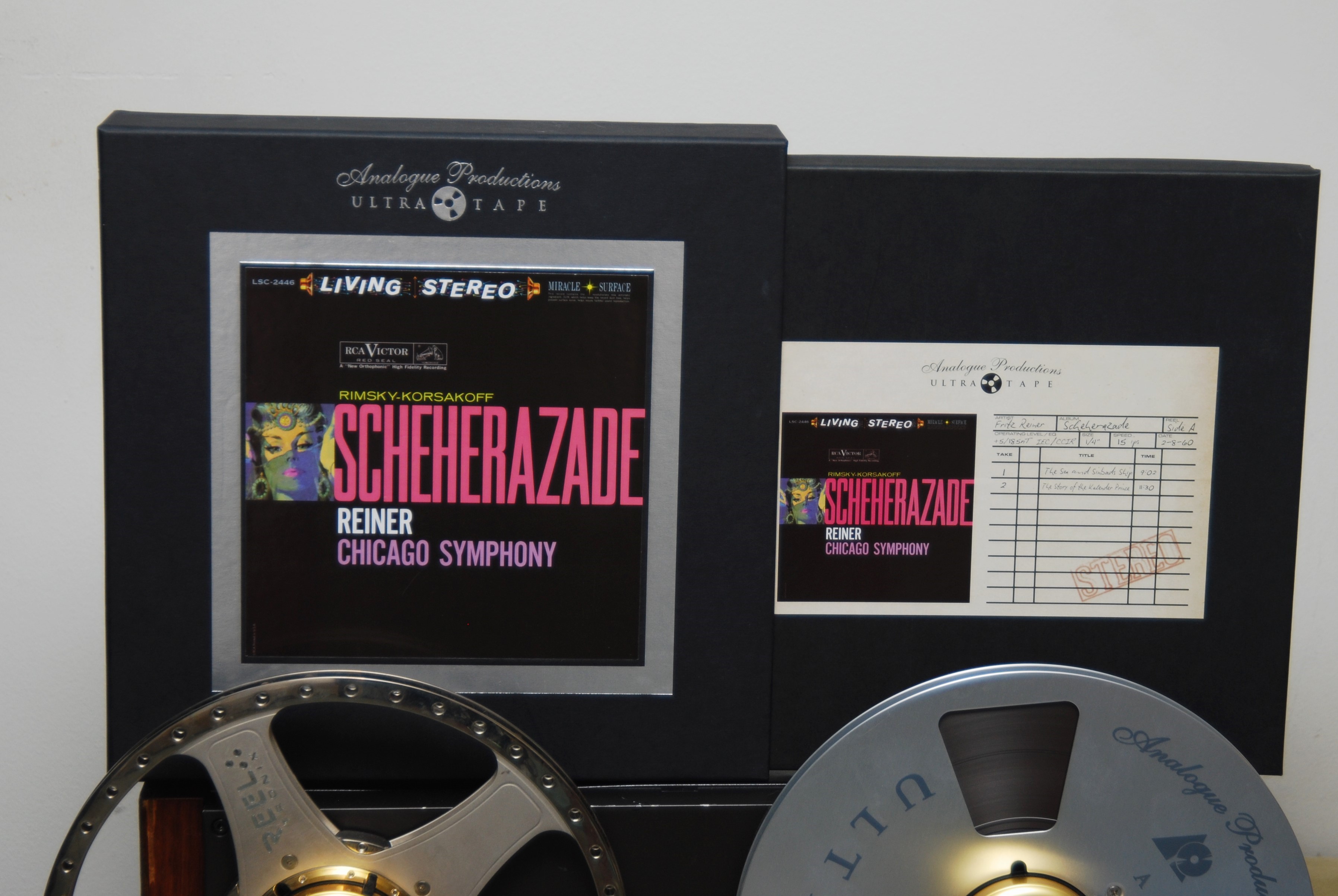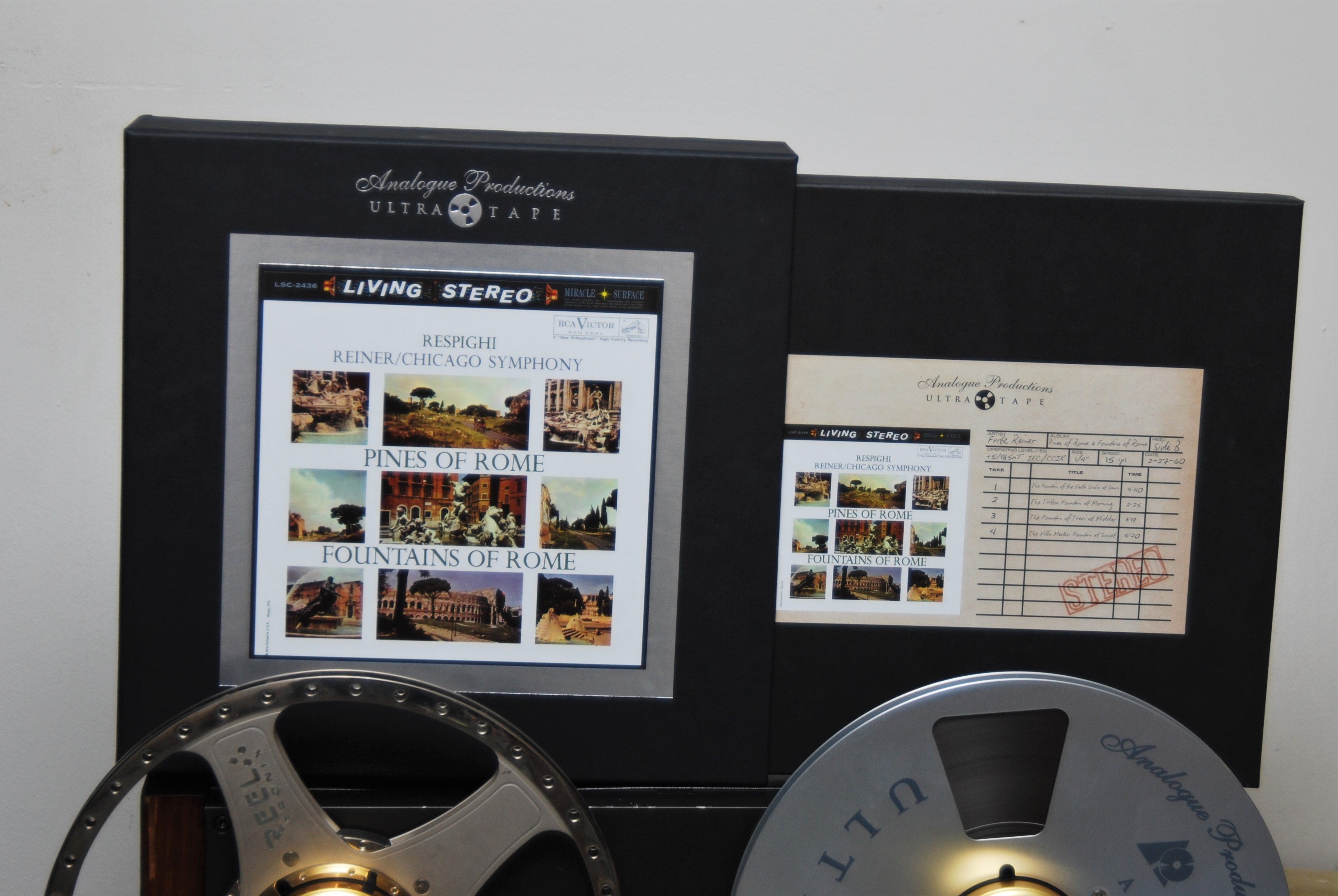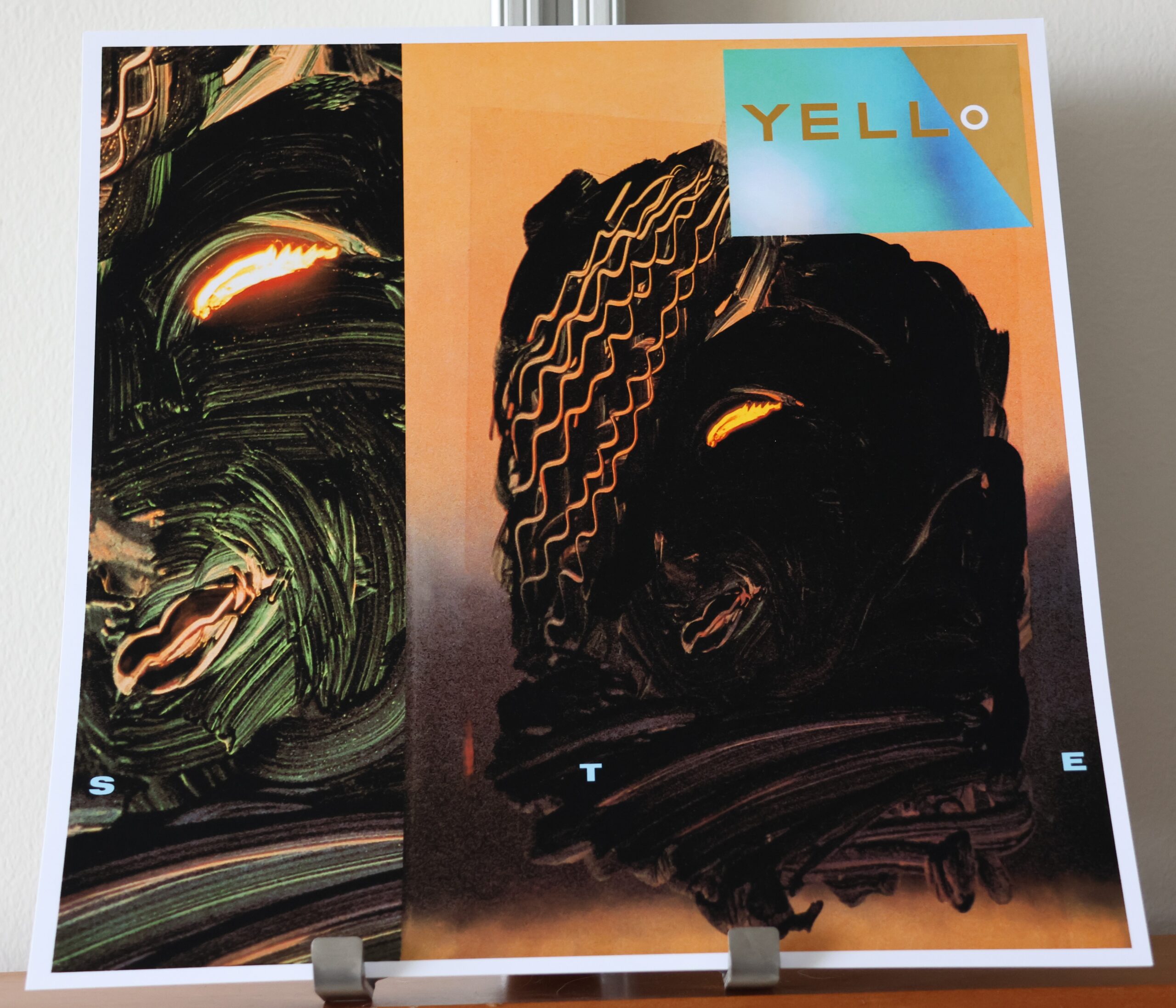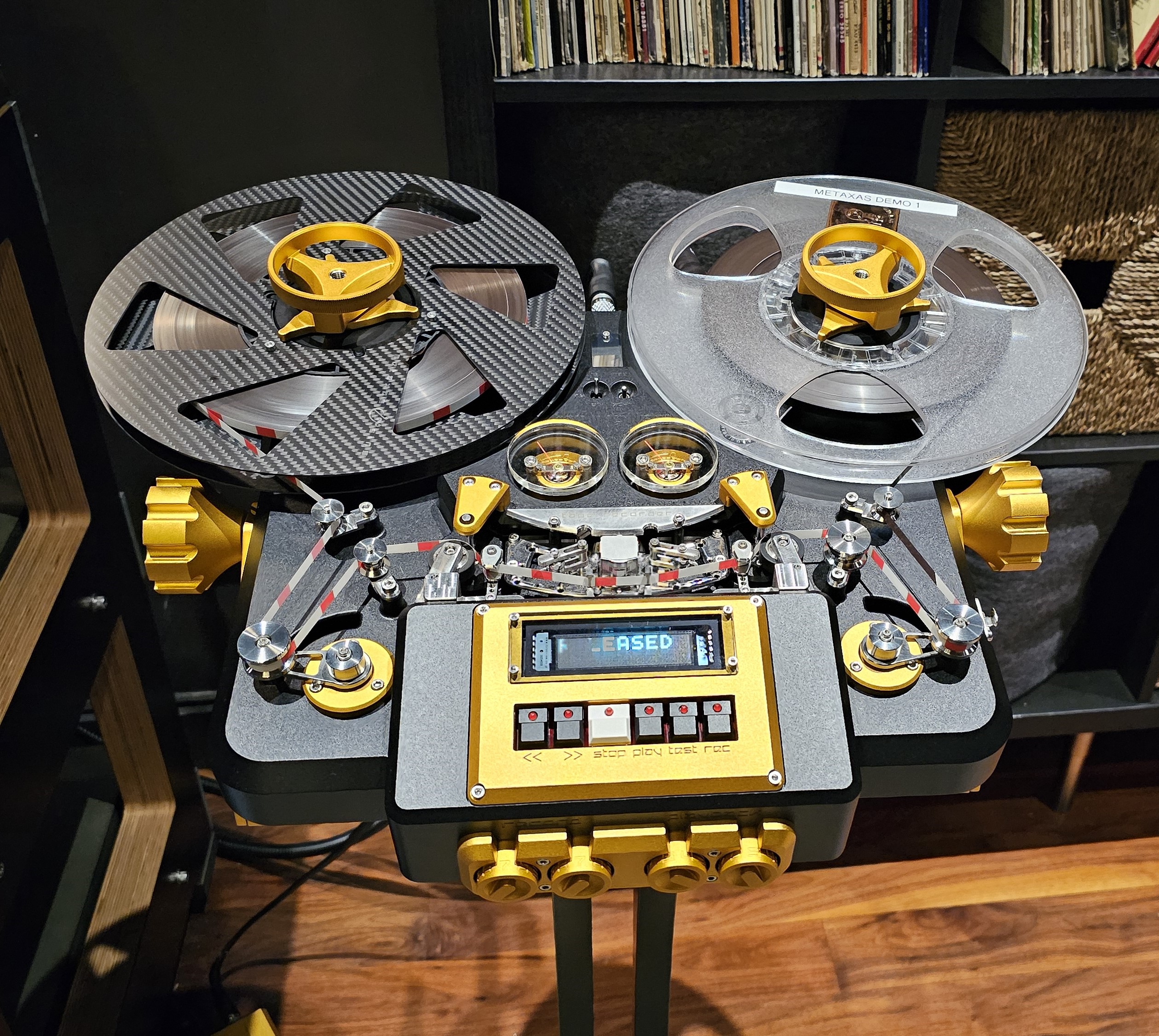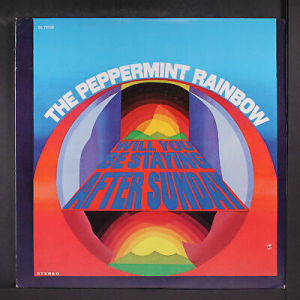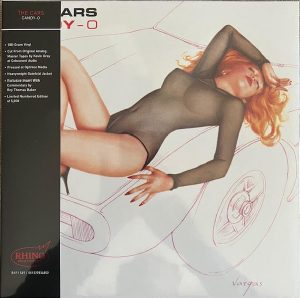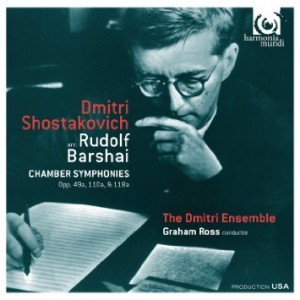Shaded dogs that is!
This isn't the first time these absolutely legendary RCA Living Stereo recordings have appeared on reel-to-reel tape (Scheherazade (FTC2017) was according to Discogs released in 1960 on four-track tape). This is, however, the very first time this pair of now close to 60 year old recordings are available on real time duped, 15-ips, 2-track tape. And what a special treat!
Back in the mid-'50s—two years prior to the release of the first stereo record in 1957—reel-to-reel stereo tape ruled the roost. Perhaps even longer because the reel-to-reel decks of that time were superior to the turntables/cartridges of the day. Only then the earliest Living Stereo tapes were 7½-ips, 2-track, NAB EQ (the earliest being in-line heads) as opposed to the current crop of 15-ips, 2-track, IEC EQ (mostly) tapes. The very earliest RCA 7½-ips, in-line heads, 2-track tapes aren't any sonic slouches either. I suspect—perhaps incorrectly—that the earliest stereo tapes might be real time duped. If not, certainly not the super high speed dupes that record labels later turned to in an attempt to mass produce reel-to-reel tapes. The sound of Bob and Ray Throw a Stereo Spectacular (LSP 1773), Offenbach's Gaite Parisienne (LSC 1817) and Dick Schory's Bang, Baa-room and Harp (LSP 1866) on 7½-ips tape are stunning and even startling at times. The low end performance of these early tape's even exceeds in some ways that of today's LP reissues. Certainly, the LP releases at that time. While there's no question that the new 15-ips, IEC equalized tapes are in a league of their own, what are chances that we'll see all these titles on tape?
Nor is this the first time that I've reviewed this particular pair of RCA Living Stereo releases. Thirty years ago, I covered for The Absolute Sound (Issue 49, p. 64-69, 1987) the much anticipated Chesky Records LP reissues of this same pair of recordings of Reiner and the Chicago Symphony. One observation that emerged from that 1987 Absolute Sound piece was that the original three-track master tape—even given the playback system at RCA—sounded far better than the two-track mixdown tape used for the original LP release. The original three-track tape was, "significantly quieter, possessing greater dynamic range, more hall ambience, more information and detail, better bass and a greater hall presence." Chad Kassem, owner of Acoustics Sounds must have heard the same thing since he returned to the original three-track 15-ips master tapes, not the two-track mixes used in mastering the original LPs, to create the new 30-ips, 2-track running masters for this latest pair of 15-ips reel-to-reel Ultra Tape! releases. (see link for video of tape transfer)
There's also another very significant and underappreciated benefit to creating a new 2-track mixdown tape. New playback heads are among other things quieter, have better frequency extremes and recover more information from the master tape than those of yesteryear. In essence, this pair of Living Stereo tapes are for all intents and purposes entirely new recordings (as are Chad's new RCA Reissues). Throw in the quietness and resolution of today's best reel-to-reel machines and these tapes reveal more about these classic recordings than ever thought possible.
A Pair of Recordings from the Golden Age of Stereo Recording
There are several ways of looking at Reiner and the Chicago Symphony's recordings of Scheherazade and The Pines of Rome. To being with, their sound (still being a benchmark some 60 years later for recoding quality). Another is the recording perspective (imagine recording these symphonies today in six or less hours on single day; the final movement of Scheherazade was recorded in one take!). But just as, if not more important, is the history behind these recordings. Fritz Reiner had moved from orchestra to orchestra dreaming of eventually leading a major American symphony orchestra. Finally, after many years of frustration, Reiner succeeds the esteemed Rafael Kubelik and remains at the helm of the Chicago Symphony Orchestra from 1953 until a heart issue forced him to retire in 1963. The rest is history and Reiner's 50 or so RCA Living Stereo recordings are a testament to both his conducting and the playing of one of the world's best orchestras. Some consider the string and brass sections of the CSO to be the best ever.
Scheherazade and The Pines of Rome were recorded with RCA's prized new acquisition: an Ampex 300-3 reel-to-reel tape machine equipped with tube electronics to boot. These masterpieces weren't, however, as pointed out in my 1987 Absolute Sound article, as simply miked as people then thought. RCA did use a pair of mikes for their "experimental" stereo recordings done in 1953 to 1954 (good for orchestral music but not soloist recordings) with possibly even a few of the early 1957 releases recorded with a trio of mikes. The bulk of RCA's early stereo classical recordings from that Golden Age, however, employed an assortment of five to nine microphones drawn from the likes of Telefunken U47s, M49s and M50s, some RCA ribbon mikes, etc. In fact, Analogue Productions includes a sheet with The Pines of Rome tape illustrating the choice and layout of the microphones used in making the recording.
Both The Pines of Rome and Scheherazade were recorded at 15-ips (3-track) on ½-inch Scotch 111 tape using (A)mpex's newly developed (M)aster (E)qualization (AME) curve. AME was a short-lived tape equalization curve invented by Ampex in an attempt to improve both the S/N ratio and dynamic range of tape recordings. Low frequencies were boosted by 5 dB at 40 Hz and often resulted in tape overload. A corresponding "8-10 dB boost centered around 4 kHz was also added." Luckily according to the people at RCA, they only used AME for about two years; later recordings, take Lt. Kije for instance, were recorded using the more common NAB equalization curve.
Michael Gray's "RCA and the First Stereo Years" sheds even more light on RCA's Living Stereo recordings (The Absolute Sound, Issue 49, p. 46-63, 1987). Chicago Symphony Hall was wider and shallower than other halls that RCA had worked in up to then and presented its own set of unique issues to the RCA recording team. By the time RCA recorded Scheherazade and The Pines of Rome, "Layton," according to Gray, "now had his own version of Decca's tree and outriggers. Save that the center mike for his trio was clearly intended for overall pickup from behind Reiner's podium rather than the woodwinds in front of it. While Layton's quintet of string mikes were aptly positioned to pick up reflections from Orchestra Hall's highly directive stage shell and from the hall behind and above them, they didn't always provide a good definitive stage. Layton therefore almost always added one or two wind mikes to his string mix with further accent mikes brought in to highlight musically important parts of the orchestra such as the piano and celeste in The Pines of Rome." The new Ultra Tapes! reveal more about the positioning of the mikes than ever. Sadly, Gray discovered in the course of writing his piece that, "All" of "RCA's old engineering files, including Layton's session set-up sheets, were destroyed in 1969 when RCA moved from its studios on 24th Street in New York." Simply mind boggling corporate incompetence!
Rimsky-Korsakov: Scheherazade, First and Second Movements (Reel A); Scheherazade Third and Fourth Movements (Reel B). Reiner and Chicago Symphony, Producer: Richard Mohr; Recording Engineer: Lewis Layton. Recorded February 8, 1960. LSC 2446.
My 1987 review for The Absolute Sound back darn near killed any love I had for this piece. It took many years after repeatedly listening to and comparing ad nauseum the different LP versions along with the CD with the Chesky reissue, to put this Living Stereo back on the turntable. To this day the most poignant memory of this review was HP's footnote about RCA's 0.5 series reissue of Scheherazade, "being half what it should have been." That man being a writer could really turn a phrase. I'm pretty sure though that if HP was still alive, he might say this tape 15 times better than the LP release.
Jump ahead 30 years and once again I find myself revisiting a familiar friend; only this time the recording is on 15-ips tape. Greenfield, Layton and March wrote of Reiner's recording of Scheherazade in the Penguin Stereo Record Guide (1977): "Reiner's account is a dramatic one, the first movement having a strong forward impulse and the finale equally brilliant and exciting. The two central movements are beguilingly played, but the readings are individual, and some may not care for the conductor's romantic nudgings here and there. However, Reiner always sounds spontaneous: there are many delightful touches and the third movement is wonderfully languorous. The recording is vivid, with the strong character of Chicago Hall adding its own atmosphere."
Rimsky-Korsakov's Scheherazade is based on the series of Middle East folk tales (that so intrigued many Russian composers of the time) known as Arabian or 1001 Nights. Scheherazade, considered one of Rimsky-Korsakov's most popular works, consists of dazzling orchestration. Musically and sonically, this recording is all about the interplay of the orchestral instruments representing the conversation between the Sultan and his new, nee latest wife Scheherazade.
Some highlights from each of the movements. The first movement "The Sea and Sinbad's Ship" starts with strings and winds (the Sultan); then the violin solo (Scheherazade) begins telling her tale. The second movement, "The Story of the Kalender Prince," is renowned for its violin solo. The following movement "The Young Prince and Princess, is a love song in waltz form. Scheherazade concludes with the "Festival in Baghdad. The Sea. The Ship Goes to Pieces on the Rocks Surmounted by a Bronze Warrior" with its frantic finale.
Scheherazade is an unqualified sonic blockbuster with the tape's dynamic range testing the mettle of even the best audio systems. That playback system better have among other things prodigious amounts of power (or say use efficient speakers) to fully reproduce those dynamic sections. In fact, more dynamics than I remembered on the LP. During this review, both my reference 275 wpc (into 4 ohm) cj ART monoblock tube amplifiers as well as the 700 wpc (into 4 ohm) Merrill Audio Veritas Class-D monoblock amplifiers were pressed into action. Both amplifiers capably demonstrated the recording's tonality and ability to capture the stunning and sensuous sound of Sidney Harth's violin solos, the strings, the woodwinds, brass and other instruments. A seemingly limitless soundstage that encompasses another zip code. (The addition of some tube dampers to the Doshi tapestage further improved the unit's tonality, imaging, soundstaging and transparency.) The orchestration and interplay among instruments—particularly between the violin and harp on the famous second movement "The Story of the Kalender Prince"—will melt your heart. Not to mention the bassoon melody followed by the entry of the oboe, violins and woodwinds as well as brass. The tape really reveals the low level detail of lower strings!
When all is said and done, it still amazes me how good these recordings sound. Certainly RCA's in house playback system was nothing to write home about consisting of MacIntosh tube electronics, Olson LC-1A speakers and a Rek-O-Kut turntable outfitted with a GE Variable Reluctance cartridge (as pointed out by one of the RCA engineers, the GE cartridge didn't initially use RIAA). The obvious answer was Mohr and Layton and the rest of the RCA team got it right to being with. Not to mention RCA had several outstanding halls to start with and as one recording engineer once said to me, "the sound of the hall is 80% of the equation."
For those curious how the tape compares to the records and whether the tape is worth the difference in price, I pulled out two original pressings (3/3S R and 6/8S I A1/A1) plus the Classic Records and Analogue Productions reissues. Keep in mind when conducting these comparisons that the original LPs are sourced from the 2-track mixdown tape while the Classic Records and Analogue Productions were mastered from the original 3-track master tape. Long story short, the original LPs in this case sound the best. The 3S pressing, despite having seen better days, definitely sounded better than the later 6S issue. The original LP contains more information, a greater sense of ambience and hall presence and better instrumental tonality. In addition, instruments possess a bit more body and presence too. Surprisingly, the originals even have a slight edge when it came to the reproduction of triangles. The Analogue Productions Scheherazade release is next best with perfect surfaces though it lacks the overall sense of space of the originals, instrumental palpability and presence. The Analogue Productions is eerily quiet, transparent and detailed (a quality that emerges when space is diminished on recordings) with wide soundstaging and dynamics. What really separates the men from the boys or the original release from the Analogue Productions reissue is Harth's opening solo at the beginning of the second movement. The Classic runs last being all over the place. Overly brilliant here and boosted there.
How does the vinyl stack up against the reel-to-reel tape? Is the reel-to-reel tape worth the difference in price? Absolutely and without any hesitation. What piqued my curiosity, though, was how the Analogue Productions vinyl reissue compared to the 15-ips tape. (or vice versa). It doesn't in this case. In reality, the sound of the Scheherazade tape is somewhere between the original and reissued LPs. Where this is most evident is during the third movement "The Young Prince and The Young Princess" love song. The tape couples the ambience, spatiality, dimensionality and harmonic envelope of the original LP with the sense of detail, weight and clarity of the reissue. Perhaps most telling was the sense of space around the different sections of the orchestra on the tape. Here the original LP is a little too thick and murky while the reissues are lacking in some respects. With the tape, there is just a feeling of clarity and see-through quality to the sound enveloping instruments and orchestral sections like experienced in person.
The tape also shows that the low end on many of the RCA Living Stereo recordings—Scheherazade and one of my favorites The French Touch being two examples—is just lacking. RCA Living Stereos will never be mistaken for a Robert Fine Mercury Living Presence recording here. Yes, the tape's low end is better than the LP and the drums definitely are bit more palpable since one can is able to see through all the way to the back of the stage. But there's no question, especially once you hear other tapes, that the low end is a bit lacking. On the other hand, the often talked about Living Stereo string sound on these recordings is absolutely amazing on this tape and even a touch better using tube dampers on the Doshi tape stage.
Respighi: Pines of Rome (Reel A); Fountains of Rome (Reel B). Reiner and Chicago Symphony, recorded October 24, 1959. Producer: Richard Mohr; Recording Engineer: Lewis Layton. RCA LSC 2436.
Reiner's recording of The Pines and Fountains of Rome is not without some interesting trivia. The Pines and Fountains of Rome were recorded on October 24, 1959 and initially released in 1960. Then disaster struck. The 1S pressing proved unplayable on the turntables of the day; the needle literally launched itself out of the groove. According to Michael Gray's footnote to my article, the 1S stamper (mastered on May 30, 1960) was cut at, "1) too high a cutting level; and 2) incorrectly set diameter equalization used to compensate for pinch effect in the inner grooves." RCA recalled both the original 1S stamper as well as stampers 2 to 5 (all had been mastered on May 30, 1960) and replaced them with the 10S stamper (mastered on August 12, 1960) 4 dB lower than the original record.
Enough about the technical end and onto the music. Ottorino Respighi was the first Italian composer of his era to attain fame and popularity for his orchestral works. Deeply influenced by Russian composer's use of orchestral color, Respighi even travelled to study with Rimsky-Korsakov in 1900 (Rimsky-Korsakov's Scheherazade is the subject of review.) He's perhaps best known for his "Roman Trilogy," though readers may also be familiar with other Respighi's compositions including Church Windows (another tone poem [1927]), Brazilian Impressions ([1928]), The Birds (1928) and Ancient Airs and Dances (1917-32). Terry Blain wrote on his website classical-music.com, "Popularity of the Trilogy has often been attributed to Respighi 's undeniable brilliance as an orchestrator, his ability to conjure up a kaleidoscopic image of crowd pleasing colors and impressions from his instrumental palette." Respighi's "Roman Trilogy" consists of the following three tone poems (Symphonic tone poems are extra musical idea story or programs with a natural sequence of events, usually consisting of a single movement or four movements without pause in the case of the The Pines and Fountains of Rome):
The Fountains of Rome
The Pines of Rome
Roman Festivals/Feste Romane
Respighi composed the three pieces in the period between 1916 to 1928 with the Fountains of Rome premiering in 1917 and Pines of Rome in 1924. Both pieces were inspired by the glories of Respighi's adopted city Rome and capture scenes around the capitol and the glory of Roman empire. Reel A contains The Pines of Rome that Respighi's wife Elsa recalled, "… was one of the compositions in which the Maestro was most emotionally involved." The Pines of Rome grew out of Respighi 's interest in older music, medieval plainchant and folk tunes that eventually led him to compose Ancient Airs and Dances.
Just as in concert, The Pines and Fountains of Rome are paired together on this RCA stereo release.
Each movement in The Pines of Rome centers around the pine trees of Rome in different locations at different times of the day. Some of the highlights of each movement include:
- "Pines of the Villa Borghese": Children playing on a sunny day with the winds and strings playing in their highest registers;
- "The Pines Near a Catacomb": Quasi-medieval like highlighted by hymn-like and meditative phrases, climaxing with strings;
- "The Pines of the Janiculum": Lighter, moonlight mood with the famous "nightingales" singing. Piano strumming introduces the movement concluding with feeling of calm;
- "The Pines of the Appian Way": Opens with Roman army marching into the city highlighted by trumpet fanfare and pounding tympani. Slow and mysterious pulsing builds into march climaxing with massive crescendo.
The Fountains of Rome on the B-reel is actually the first of Respighi's Roman trilogy with each movement portraying of Rome's fountains at different times of the day. To take a quote from the Houston Symphony playbill, "Character in harmony with the landscape."
- "Fountain of the Valle Giulia at Dawn": Grandest of the fountains at break of dawn;
- "The Triton Found in the Morning": Cattle passing in the mist and the calm before the Trevi fountain. Introduced by the sudden blasts of horns;
- "Trevi Fountain at Noon": Looking down from hill overlooking St. Peters. Opens with sad theme following with swell of orchestra ending with calm and delicacy;
- "Villa Medici at Sunset": Melancholy atmosphere marks the arrival of night. Strings and woodwinds and percussion including celeste and bells, birds twittering and leaves rustling.
Just like their predecessors, this pair of 15-ips, 2-track tapes also set the standard for sonics. The Pines of Rome in particular is a musical tour de force and sonic blockbuster. It is mind blowing that this pair of Respighi pieces recorded almost 60 years ago still stands the test of time. Soundstaging. Orchestral authority. Dynamics and dynamic transitions not to mention the sheer scale of sound on the last movement. Brilliant brass. For the very first time, listeners really get to hear in its full glory what no LP, new or old, is able to convey. Hear how Layton pushed the tape to the max and maybe even a touch more. Then there's the power and authority of the piece especially on the last movement.
How does The Pines of Rome tape compare to the original or LP reissues? Here two originals 5S/5S (A2/A1 R [mastered a week after the 1-4S lacquers on June 6, 1960]) and 15S/14S (A2/A1 I [mastered on August 26, 1960]) and the recent Analogue Productions release were played back on the VPI's direct drive Vanquish turntable with the latest 12-inch, dual pivot, 3D arm replete with a Lyra Atlas SL cartridge. Neither original or reissues LP are perfect and each gives a little different perspective on the master tapes. Not surprisingly, the original 5S stamper is markedly better than the re-issued and re-engineered later 15S pressing. Besides compression, the later reissue simply gets nasty during the last movement of The Pines of Rome. The earlier release (I didn't have an original 1S pressing for comparison though the 5S since it seems to be cut close to the 1S specs) has a little better midrange quality while the Analogue Productions reissue is more dynamic and a cleaner cut. The original has a touch more hall sound while the Analogue Productions reissue clearly has a better foundation. Of course, there's no contest when it comes to record surfaces. Here the Analogue Productions wins hands down. There is also something to the vinyl quality: the quieter the system, the more apparent the higher noise floor of the older vinyl pressings.
It certainly wouldn't be going out on a limb to say that Scheherazade and The Pines of Rome were two of the most anticipated Analogue Productions Ultra Tape! Series releases. High expectations sometimes lead to disappointment, but not here! Both reel-to-reel tape releases live up to and exceeded expectations, especially in terms of recreating the original recordings dynamics, spatiality, and resolution. I for one can't wait to hear the upcoming release of Reiner's Lt. Kije (and the highly underrated B-side of Stravinsky's Song of the Nightingale!) as well as that Kenneth Wilkinson blockbuster and long time reference recording The Power of the Orchestra! My most highest recommendations!
Price per tape: $450




